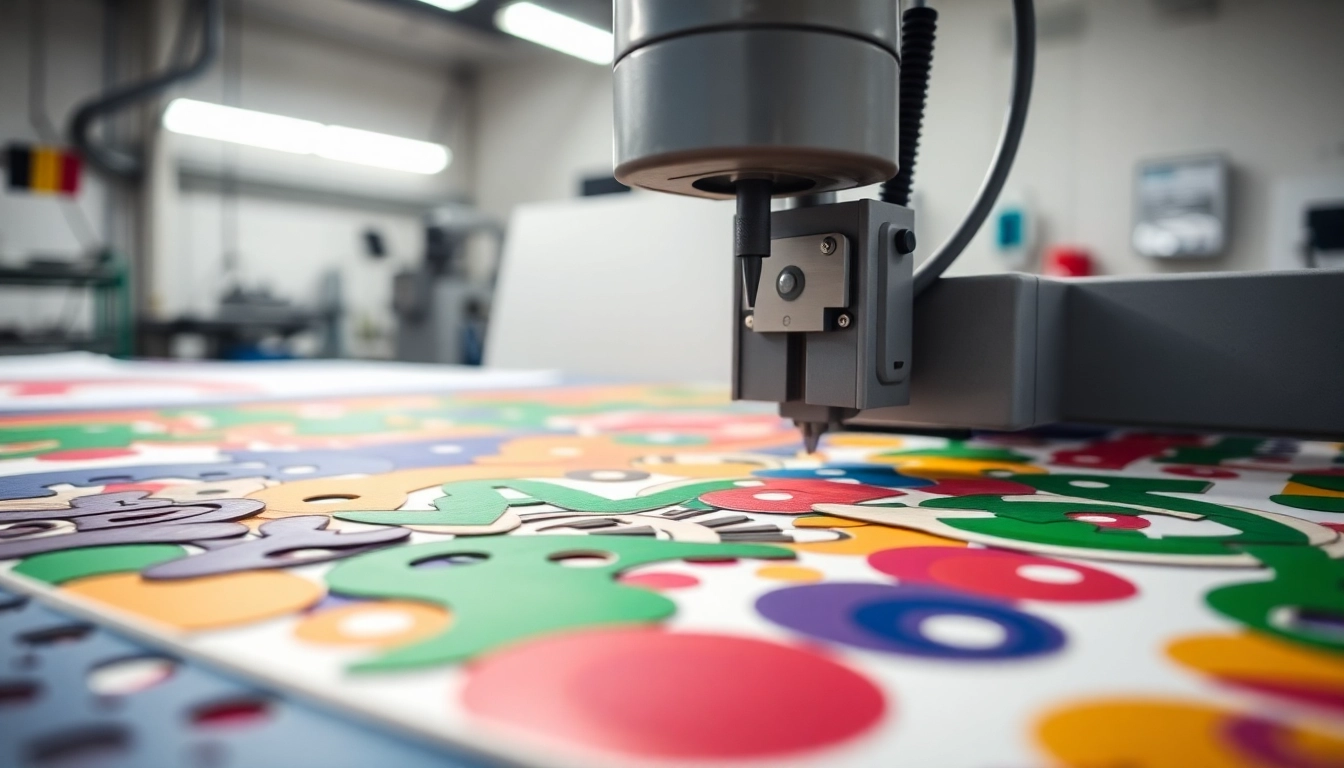Understanding Precision Die Cutting
Precision die cutting is a crucial manufacturing process that allows for the accurate conversion of materials into specific shapes and designs. This technique is vital for various industries, including packaging, automotive, electronics, and medical devices. By employing advanced technology, businesses can achieve a level of detail and uniformity that enhances product quality and operational efficiency. This article aims to provide a thorough overview of precision die cutting, exploring its benefits, applications, and the intricate process that makes it a preferred choice among manufacturers. For more detailed information, you can explore our page on precision die cutting.
What is Precision Die Cutting?
Precision die cutting is a process used to cut materials into specific shapes using a die, which is a specialized tool typically made from hardened steel. This technique enables manufacturers to produce precise and consistent parts from various substrates, including paper, plastic, foam, and metal. Precision die cutting is especially valuable when high volumes of identical parts are required, making it a go-to method for mass production.
Key Benefits of Using Precision Die Cutting
- Accuracy and Consistency: Precision die cutting ensures that every part produced is identical, which is critical in sectors where precision is paramount, such as aerospace and medical.
- Cost-Effective for Large Runs: While the initial investment in die creation can be significant, the cost per unit decreases substantially with larger production runs.
- Material Versatility: This method can accommodate a wide range of materials, increasing its applicability across various industries.
- Accuracy in Design: Complex designs can be reproduced with ease, allowing for innovation in product design without sacrificing quality.
- Reduced Waste: The die-cutting process is optimized for material usage, leading to less waste compared to other cutting methods.
Applications Across Industries
The applications of precision die cutting are vast and diverse. Here are some notable examples:
- Packaging: In the packaging industry, precision die cutting produces boxes, inserts, and packaging materials tailored to specific product dimensions.
- Automotive: Automotive manufacturers use precision die cutting for components such as gaskets, seals, and trim parts, ensuring a perfect fit and functionality.
- Electronics: Electronic device manufacturers rely on precision die cutting for parts like insulation, grommets, and protective covers that must meet strict dimensional tolerances.
- Medical Devices: In the medical field, precision die cutting aids in producing components for devices, ensuring high standards of hygiene and safety.
- Textiles: The textile industry benefits from precision die cutting for fashion and upholstery, enabling intricate designs and patterns to be cut with precision.
The Precision Die Cutting Process
Materials Used in Precision Die Cutting
Precision die cutting can process a variety of materials, and the choice of material often depends on the specific application. Common materials include:
- Cardboard: Widely used in packaging and promotional materials, offering a cost-effective option for die-cut products.
- Plastic: Available in various types, including PVC, PET, and acrylic, which are used in signs, packaging, and more.
- Foam: Utilized for protective packaging, cushioning, and insulation products due to its lightweight and shock-absorbent qualities.
- Metal: Thin sheets of metals like aluminum or stainless steel are die cut for precision components in the automotive and aerospace sectors.
- Paper: High-quality paper die cutting is commonly used in crafting, education, and packaging, allowing for complex designs.
Steps Involved in the Die Cutting Procedure
- Design Development: The process begins with creating a design that outlines the shape and dimensions needed for the die. CAD software is often used for this step.
- Die Creation: Once the design is approved, a die is fabricated according to specifications. This process can be time-consuming but is crucial for accuracy.
- Material Preparation: The chosen material is prepared, ensuring it is clean and suitable for die cutting.
- Die Cutting: The prepared material is placed in the die-cutting machine, and pressure is applied through the die to cut the material into the desired shape.
- Post-Processing: After cutting, the parts may undergo additional processes like sorting, cleaning, or finish treatments to enhance quality.
Choosing the Right Die Cutting Method
There are several methods of die cutting, and the choice depends on the project requirements. The primary methods include:
- Flatbed Die Cutting: Utilizes a flat surface to cut materials, ideal for thicker substrates and single sheets.
- Rotary Die Cutting: Uses a rotating die, making it suitable for continuous rolls of material, ensuring high speed and efficiency.
- Laser Die Cutting: Involves laser technology and is ideal for intricate designs but may be slower and more costly than traditional methods.
Market Trends in Die Cutting Technology
Current Innovations in Precision Die Cutting
The die cutting industry has seen several innovations aimed at improving efficiency, quality, and sustainability:
- Advanced Cutting Technologies: Innovations such as laser-assisted die cutting and digital die cutting are gaining traction, providing increased flexibility and precision.
- Integration with Automation: Many die-cutting facilities are investing in technology that automates the cutting process, allowing for faster production while reducing human error.
- Eco-Friendly Practices: Manufacturers are increasingly focused on sustainability, opting for recyclable materials and processes that minimize waste.
How Automation is Shaping the Industry
Automation is revolutionizing traditional manufacturing processes, including precision die cutting. By implementing automated die cutting machines, companies can:
- Increase Production Speed: Automated machines operate faster than manual processes, allowing for quicker turnaround times.
- Enhance Precision: Automation minimizes human error, leading to more consistent cuts and higher quality products.
- Save Costs: By reducing labor costs and increasing efficiency, companies can optimize their operations for better profitability.
Future Projections for Die Cutting Services
Looking forward, the precision die cutting market is expected to grow significantly. Key projections include:
- Increased Demand: As industries continue to seek customization and rapid prototyping, the demand for precision die cutting services is set to rise.
- Emerging Markets: Developing countries are expected to invest in modern manufacturing capabilities, including die cutting technology, driving globalization in this sector.
- Technological Advancements: Continued innovations in materials, machinery, and processes are likely to enhance the capabilities and efficiency of precision die cutting.
Choosing the Right Precision Die Cutting Service
Factors to Consider When Selecting a Provider
When choosing a precision die cutting service, several factors should be taken into account:
- Experience and Expertise: Look for providers with a proven track record in the industry and expertise in handling specific materials and designs.
- Quality Assurance Measures: Ensure that the provider has stringent quality control processes in place to maintain high standards throughout production.
- Technology Utilization: Providers using advanced technologies for precision die cutting can deliver better results and efficiency.
- Customer Service: Strong communication and support from the service provider can facilitate smoother project management.
Evaluating Quality and Speed in Die Cutting
To evaluate potential precision die cutting services, consider two critical metrics: quality and speed. High-quality die cutting services ensure:
- Consistent Accuracy: Regular checks and calibrations prevent variations in the cutting process.
- Quick Turnaround Times: The service should provide a balance between high quality and efficient production schedules.
Cost Considerations for Precision Die Cutting
Understanding the cost implications of precision die cutting is vital for budgeting:
- Initial Die Costs: Costs often include the design and fabrication of the die, which can be substantial for complex shapes.
- Material Costs: The choice of material will affect overall costs; some substrates are more expensive than others.
- Production Volume: Higher volumes typically lead to lower per-unit costs, making it crucial to assess your production needs accurately.
Best Practices for Maximizing Precision Die Cutting Efficiency
Design Tips for Effective Die Cutting
Effective design is a cornerstone of successful precision die cutting. Consider the following tips:
- Simplicity in Design: The more complex the design, the harder it will be to cut accurately. Simplify wherever possible.
- Consider Material Thickness: Factor in the thickness of materials when designing the cuts to avoid issues during production.
- Test Cuts: Run preliminary tests to ensure the design functions as intended without defects.
Quality Control Measures in Die Cutting
Establishing quality control measures is critical to ensuring that die-cut products meet specifications:
- Regular Inspections: Schedule routine inspections throughout the production process to identify and rectify issues early.
- Utilizing Statistical Process Control: Implement statistical tools to monitor cutting precision and material usage continuously.
- Feedback Loops: Encourage feedback from production staff to identify potential improvements in methods and processes.
Measuring Success: KPIs for Die Cutting Projects
Establishing Key Performance Indicators (KPIs) is essential for measuring the success of precision die cutting projects. Consider the following KPIs:
- Production Efficiency: Measure the number of parts produced per hour against target rates.
- Defect Rates: Track the percentage of defective parts produced to maintain quality standards.
- Material Yield: Evaluate how much material is used versus how much is run to ensure minimal waste.
- Customer Satisfaction Ratings: Collect feedback from clients to assess satisfaction levels and identify areas for improvement.



